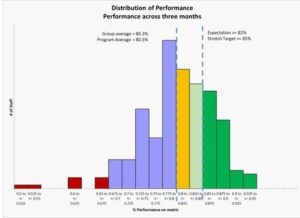
June 4, 2024
In numerous instances, leadership executes performance oversight through a methodology termed “management by objectives” (MBO). This approach entails setting a goal, holding people accountable for it, and providing incentives upon attainment (and then setting a higher goal). Conversely, managers enforce corrective strategies or punitive actions, such as withdrawing bonuses, if the objective is unmet.
In theory, this approach is sound and generally effective. However, in our eagerness to enhance performance, we often overlook the significant contributions of the middle-tier performers. While we praise the outstanding achievers, we tend to neglect those in the second quartile—individuals who have outperformed many but receive little recognition or reward for their hard work and dedication.
Performance Distribution Analysis

Consider the example where a team or program measures performance based on a specific metric—let’s use customer satisfaction (CSAT) as an example. The exact measure isn’t the point here; it could be any performance metric or key performance indicator (KPI).
Now, let’s examine the performance distribution. It typically forms a normal curve, with some team members excelling and others underperforming. Naturally, businesses will develop action plans for the bottom performers—the ones marked in red on the left side of the curve, representing roughly 10% of the team.
Next, focus on the right side of the curve. About 12% to 15% of the team, highlighted in deep green, exceed the high-performance expectations set by management, which, in this example, is achieving a CSAT score above 85%. Managers celebrate, reward, incentivize, and even consider these individuals for promotion.
The Significant Middle Segment
This approach is commendable, but let’s take another look. In this case, there’s a substantial segment, roughly 35 to 40%, marked in light green and gold. Those in gold perform better than most, consistently exceeding the program’s average across the enterprise. This is a typical scenario where the target is quite challenging, and only a few manage to meet it. However, the general principle holds true even if performance is close to the target.
Let’s consider those in light green. They perform even better than those in gold, surpassing expectations on paper (about 82% in this case) and are very close to the 85% mark. However, since they haven’t crossed the threshold, they don’t qualify for any reward or incentive.
The middle performers do not get anything for performing better than others because they are not “the best.”
The Employee Perspective
You might argue that “They haven’t met their target. It’s right that they should not get rewarded…” You may even go a step further and say, “…which is exactly what will motivate them to stretch further next time and push to meet the targets.”
But consider it from the employee’s perspective. Imagine you are Anaya, a member of this program’s 15-person team. Anaya is part of the light green group, scoring 83%. She discovers that others in her team have similar scores. While she performs better than many, she knows she hasn’t reached the deep green level.
The Impact of Unattainable Rewards
When incentives are announced and reward functions held, Anaya notices that only one or two people typically receive rewards. She asks around and realizes none of her colleagues have ever received any incentives. Gradually, it seems as if the rewards are unattainable, reserved only for the elite few, the stars. This disillusionment grows month after month.
Soon, the rewards lose their motivational power. According to Victor Vroom’s expectancy theory, rewards must be perceived as achievable to motivate individuals. Here, we mistakenly believe that setting high goals drives performance. In reality, it fosters anxiety, stress, and disengagement.
The Need for Consistent Performance
From a leadership and management perspective, consider this: We aim for consistent, sustained performance rather than relying solely on superstars. Like cricket, this is a team sport. We need players who score hundreds of runs, but we also need those who keep the scoreboard ticking during the slog overs to maintain a strong average.
So, if 40% of your team are like Anaya, it won’t be long before your overall team average starts to decline. The lack of recognition and rewards for this substantial segment can erode their motivation, leading to a dip in performance across the board. Sustainable success depends on nurturing and incentivizing all contributors, not just the top few.
This is a slow-ticking time bomb. We need to address it promptly.
Strategies for Improvement
Managing people is complex, and there isn’t a one-size-fits-all solution. What works in some situations might not work in others. However, here are three strategies that COPC has found to be generally effective:
1. Look at the Spread – Not Just the Top Order but also the Middle Order
Remember, the bulk of performance stems from the middle two quartiles, with the second quartile being key for overall team success. Examine the individuals in this group. Understand their profiles, their work methods, and how to help them improve slightly.
Often, we have specific action plans for those in the bottom quartile but not for the middle group. Implementing targeted action plans, coaching, and mentoring for these individuals can significantly enhance their performance, engagement, and motivation. In COPC’s experience, this approach has led to a sustained, steady improvement in performance among these employees.
2. Give the “Almost-There” Group a Label
Motivation often comes more from recognition than from monetary rewards. In some places, the leadership team gives this middle group catchy, aspirational names like ‘Road Warriors’ or ‘Seekers,’ which works wonderfully.
Naming this group serves two purposes: acknowledging they are better than average and indicating they haven’t achieved the top goals. This recognition shows that they are crucial in driving overall team performance.
Create action plans specifically for this group. Bring them together to share ideas. Pair them with top performers to learn from them. Encourage them to mentor those in the third and fourth quartiles. Though they aren’t the best, they are still better and can inspire the entire team.
3. Spread the Love
At the risk of sounding bold, examining incentive distribution is imperative. There are several common issues in the industry regarding this. Sometimes, managers try to save money, believing they benefit the company. We have seen situations where half of the annual rewards and recognition budget is saved and carried over to the next fiscal year as savings.
In other cases, the distribution is so skewed that only 2% of employees receive incentives. The goal is not to increase the total amount spent on rewards but to ensure a more equitable distribution. This approach can motivate employees, make the rewards seem attainable, and encourage everyone to strive for better performance.
Focusing on the middle performers, providing them with recognition, and offering even modest rewards can significantly boost overall performance and sustain it for your business. This approach will also enhance the morale of the majority of your team, leading to a more motivated and productive workforce.

Author
Shreekant Vijaykar
President of South Asian and ASEAN Operations, COPC Inc.